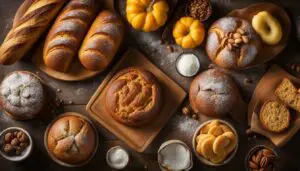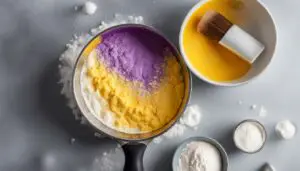Originally posted on February 10, 2024 @ 8:30 am
Vanilla is a versatile ingredient that adds flavor and aroma to a wide range of recipes. It enhances the taste of other ingredients and provides a sweet and floral note to dishes. Whether used in baking, desserts, or savory dishes, vanilla is cherished for its ability to elevate the overall flavor profile of a recipe. Its rich and complex flavor comes from compounds like vanillin, which is responsible for the distinct aroma and taste of vanilla. With its numerous applications and benefits, vanilla is a must-have ingredient in any kitchen.
Contents
- 1 The Basics of Taste Perception
- 2 Vanilla Bean Chemistry
- 3 Vanilla’s Impact on Flavor Enhancement
- 4 Psychological Effects of Vanilla Flavor
- 5 Vanilla in Sensory Research Applications
- 6 New Uses for Vanilla
- 7 Vanilla Proliferation in Retail Stores-Back to Home Cooking
- 8 Conclusion
- 9 FAQ
- 9.1 What does vanilla do in a recipe?
- 9.2 What are some vanilla extract uses in cooking?
- 9.3 What are the flavor benefits of vanilla?
- 9.4 How does taste perception work?
- 9.5 What compounds are found in vanilla beans?
- 9.6 How does vanilla impact flavor enhancement in recipes?
- 9.7 What are the psychological effects of vanilla flavor?
- 9.8 How is vanilla used in sensory research?
- 9.9 What are some new uses for vanilla?
- 9.10 Why has vanilla become more available in retail stores?
- 9.11 How does vanilla enhance recipes?
- 10 Source Links
Key Takeaways:
- Vanilla adds flavor and aroma to a wide range of recipes.
- It enhances the taste of other ingredients and provides a sweet and floral note.
- Vanilla’s rich and complex flavor comes from compounds like vanillin.
- Vanilla is a must-have ingredient in any kitchen.
- Its applications extend to baking, desserts, and savory dishes.
The Basics of Taste Perception
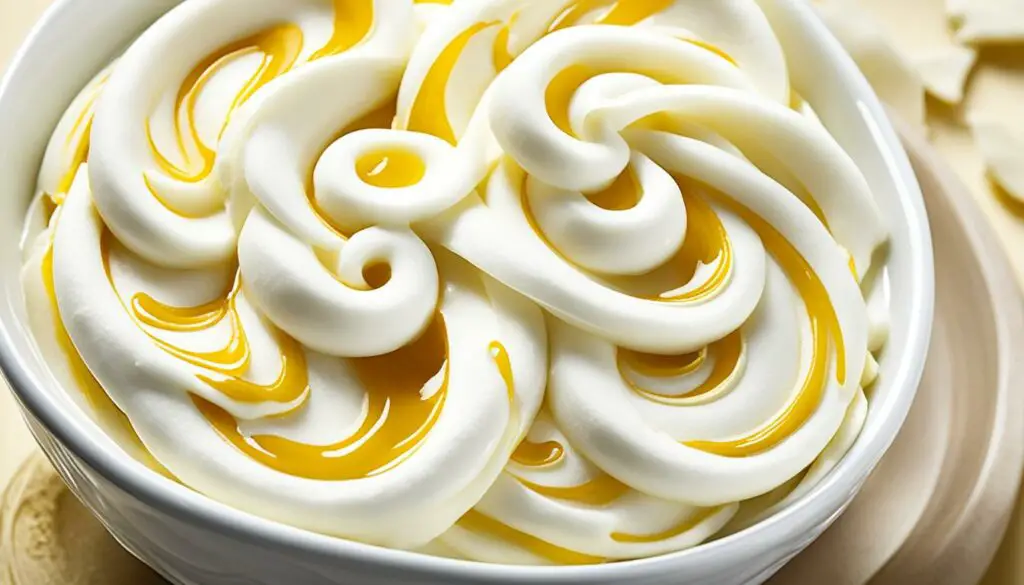
Taste perception plays a crucial role in our overall flavor experience when enjoying food. It involves our sense of taste and other sensory information, working together to create a multi-dimensional sensation. When we consume food, it undergoes a fascinating journey within our bodies, interacting with our taste receptors and sending signals to our brain.
Our tongue is home to specialized cells known as taste receptors, which detect the basic tastes: sweet, sour, salty, bitter, and umami. These receptors are like gatekeepers that allow us to experience the distinct flavors in our food.
Once the molecules from the food reach our taste receptors, they initiate a chemical reaction that sends electrical signals to the brain. These signals are then processed and interpreted by the brain, allowing us to perceive tastes and distinguish between different flavors.
Taste perception is not solely determined by the taste receptors on our tongue. It is influenced by various factors that shape our flavor experience. Genetics, for example, can play a role in our sensitivity to certain tastes. Additionally, our culture and previous experiences with flavors can impact how we perceive and interpret taste.
Interestingly, taste perception is also influenced by external factors, such as the presentation of food and the environment in which it is consumed. Factors like plating, temperature, and ambiance can enhance or alter our perception of taste.
How does vanilla enhance the overall flavor experience?
Now that we understand the basics of taste perception, we can appreciate how vanilla enhances the overall flavor experience in recipes. Vanilla’s unique flavor profile, with its sweet and floral notes, adds depth and complexity to dishes. Its presence can balance and harmonize other flavors, intensify existing tastes, and create a pleasant aroma.
Vanilla’s impact on taste perception is not limited to sweet dishes alone. It can also enhance the flavors of savory dishes, contributing to a more well-rounded culinary experience.
By incorporating vanilla into recipes, whether it’s through vanilla extract or vanilla beans, we can elevate the taste sensation and create a more enjoyable and memorable flavor experience.
Vanilla Bean Chemistry
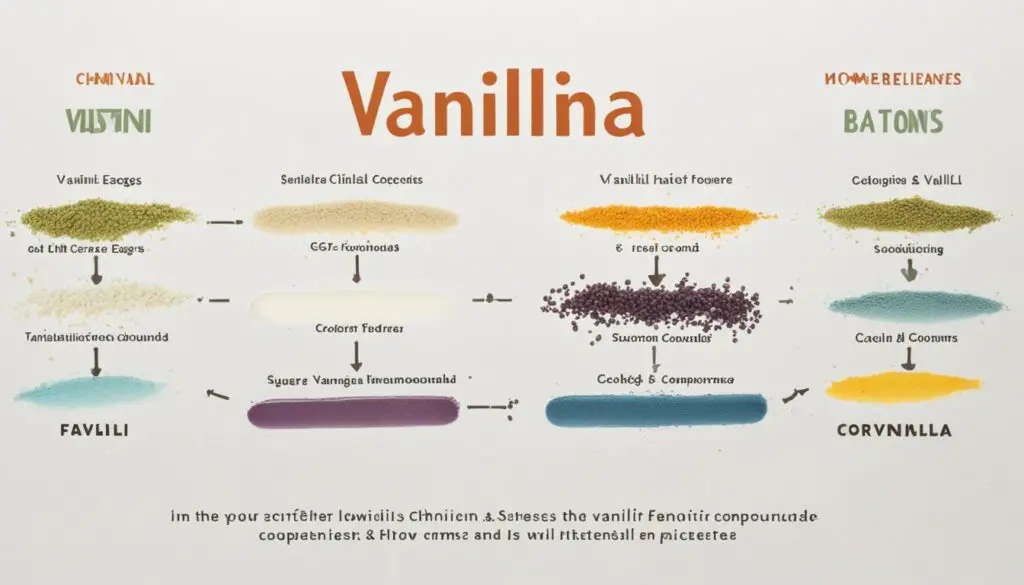
The chemistry of vanilla bean is fascinating and complex. At the heart of its aromatic and flavorful qualities is a primary chemical component known as vanillin. Vanillin is responsible for the characteristic sweet, creamy, and slightly woody aroma that we associate with vanilla.
However, vanilla beans contain more than just vanillin. They are also rich in other compounds such as alcohols, esters, and acids, all of which contribute to the overall flavor profile of vanilla.
“The chemical composition of vanilla can vary depending on factors like growing conditions and processing methods,” explains Dr. Maria Rodriguez, a flavor chemist at the University of Culinary Arts. “These variations in chemistry give rise to the diverse range of flavors and aromas found in different types of vanilla.”
To extract the desired compounds from vanilla beans, various extraction methods are employed. These methods aim to capture and concentrate the flavorful compounds while preserving their integrity.
Let’s take a closer look at the chemical components found in vanilla beans:
| Compound | Flavor Contribution |
|---|---|
| Vanillin | Characteristic sweet, creamy, and slightly woody aroma |
| Alcohols | Provide nuances of fruitiness and floral notes |
| Esters | Contribute to the fruity and sometimes spicy flavors |
| Acids | Add brightness and complexity to the flavor profile |
Understanding the chemistry of vanilla gives us valuable insights into its flavor and aroma characteristics. These insights help us appreciate how vanilla enhances the taste experience in recipes and why it is such a beloved ingredient in the culinary world.
Vanilla’s Impact on Flavor Enhancement
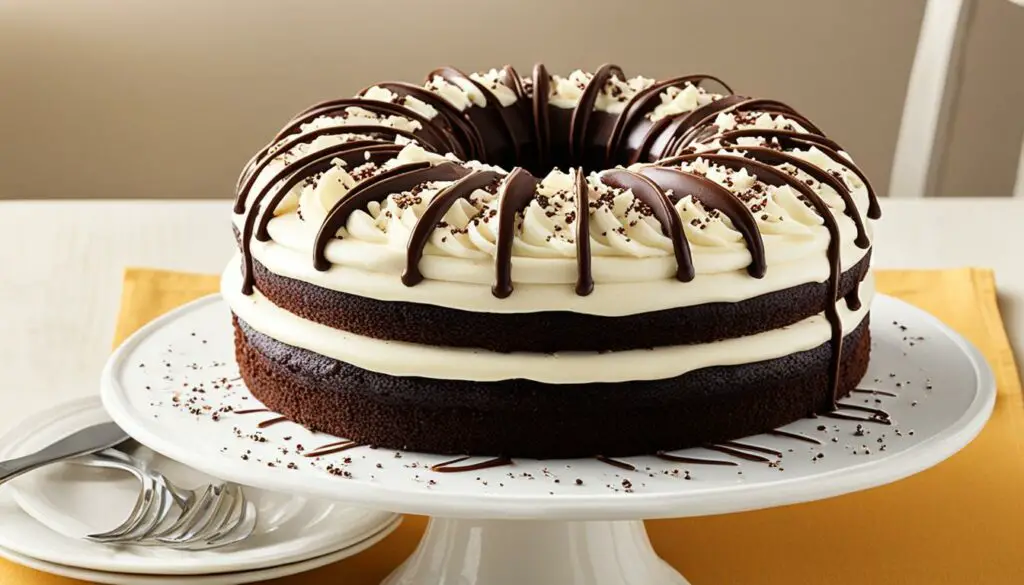
When it comes to enhancing the flavor of dishes, vanilla is a game-changer. Its unique properties and rich taste make it a valuable addition to a wide range of recipes. Vanilla not only intensifies existing flavors but also adds depth and complexity to the overall taste experience.
Adding vanilla to a recipe has a harmonizing effect, effectively balancing different flavors and creating a well-rounded dish. The sweet and floral notes of vanilla complement and enhance a variety of ingredients, whether it’s used in baked goods, desserts, or savory dishes.
One of the key strengths of vanilla is its versatility. It has the ability to enhance flavors in both sweet and savory recipes, making it a go-to ingredient for chefs and home cooks alike. The addition of vanilla can elevate a simple dish to a whole new level, transforming it into a culinary masterpiece.
By understanding how vanilla interacts with other flavor compounds, chefs and home cooks can create well-balanced and flavorful dishes. Its impact on flavor enhancement goes beyond simply adding a sweet taste. It adds complexity, aroma, and a touch of sophistication to any recipe.
| Benefits of Vanilla in Flavor Enhancement |
|---|
| Intensifies flavors: Vanilla intensifies the taste of other ingredients, making them more pronounced and satisfying. |
| Adds depth and complexity: The rich flavor profile of vanilla adds layers of complexity to dishes, making them more interesting and enjoyable. |
| Smoothes and balances: Vanilla has a harmonizing effect on different flavors, ensuring a well-balanced and cohesive taste experience. |
| Enhances aroma: The distinct aroma of vanilla enhances the overall sensory experience of a dish, enticing the senses and creating anticipation. |
| Creates a memorable experience: Vanilla’s impact on flavor enhancement leaves a lasting impression on the palate, making the dining experience more memorable. |
Whether you’re baking a batch of cookies, preparing a decadent dessert, or experimenting with a savory recipe, don’t underestimate the power of vanilla. Its ability to enhance flavors and create a well-balanced taste profile is truly remarkable.
Discover the endless possibilities of vanilla and unlock new dimensions of flavor in your cooking.
Psychological Effects of Vanilla Flavor
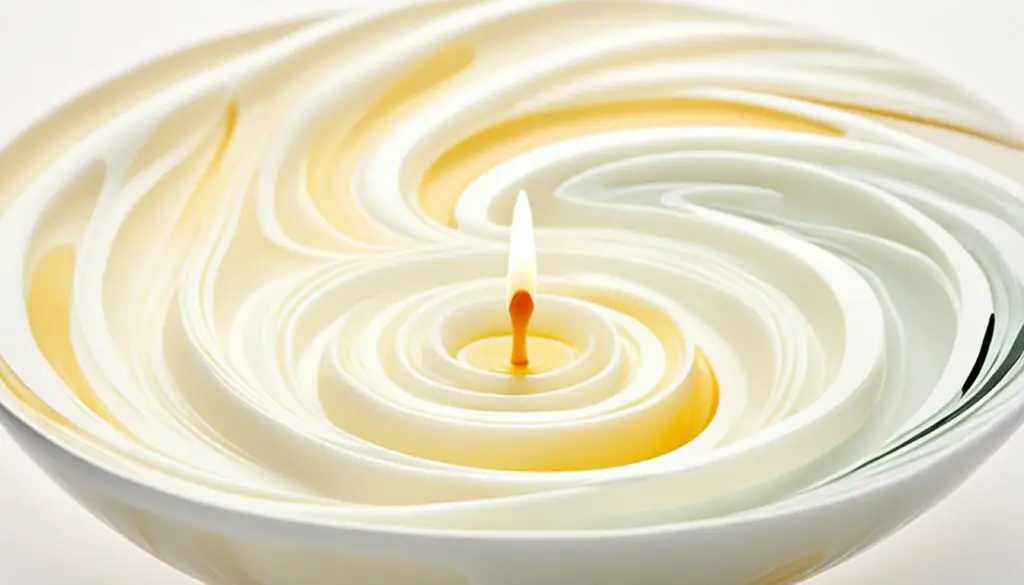
Vanilla is not only a delicious flavor but also has unique psychological effects on individuals. The comforting aroma and taste of vanilla can evoke feelings of nostalgia, relaxation, and joy, making it a popular choice in various sensory therapies and relaxation techniques like aromatherapy. The sweet and familiar scent of vanilla has a soothing influence on the mind, reducing anxiety and stress levels.
Studies have shown that the aroma of vanilla has mood-enhancing properties, as it stimulates the release of endorphins, the “feel-good” hormones in the brain. This can create a sense of comfort and happiness, lifting one’s spirits and promoting well-being.
Vanilla is often associated with indulgence and pleasure. Its presence in desserts and sweet treats triggers positive emotions and enhances the overall sensory experience. Just think about the warm aroma of freshly baked vanilla cookies or the creamy sweetness of a vanilla milkshake – these flavors can transport us back to cherished childhood memories and create a sense of joy.
Moreover, the psychological impact of vanilla extends beyond personal experiences. Vanilla is widely used in consumer products like perfumes, candles, and air fresheners due to its pleasant and inviting aroma. Its presence can enhance the perceived quality and desirability of these products, making it a popular choice among manufacturers and consumers alike.
Understanding the psychological effects of vanilla allows us to harness its potential in promoting well-being and creating enjoyable culinary experiences. By incorporating vanilla into our favorite recipes and surrounding ourselves with its soothing aroma, we can tap into its comforting and mood-enhancing properties, adding a touch of nostalgia and bliss to our daily lives.
Vanilla in Sensory Research Applications
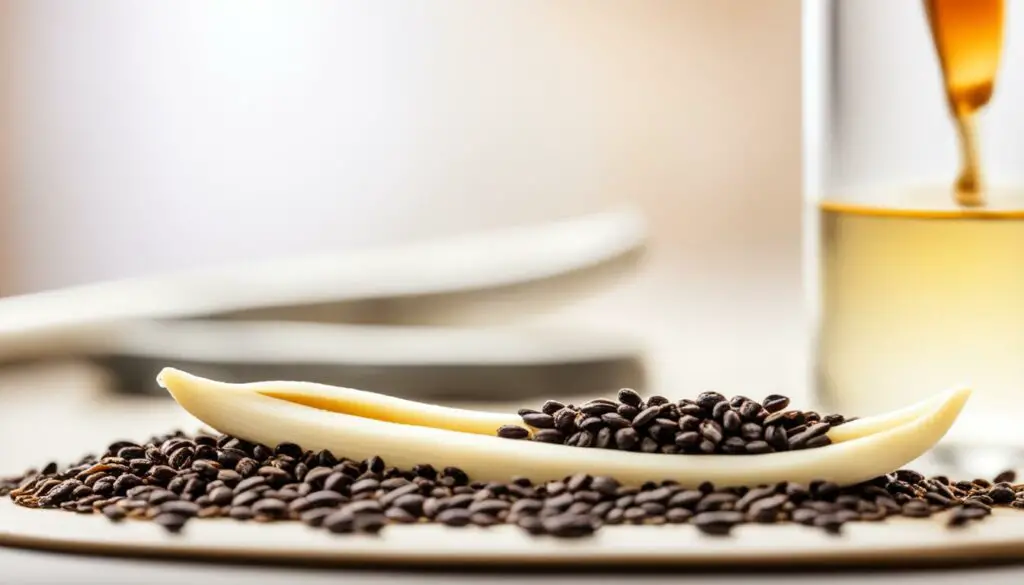
Vanilla’s role extends beyond its flavor and aroma enhancement in recipes. It is a vital component in sensory research, where scientists delve into how individuals perceive and respond to different flavors. By studying vanilla’s impact on taste perception, researchers gain valuable insights into the intricate mechanisms that influence our flavor experiences.
In sensory research, vanilla serves as a fascinating subject due to its rich and complex flavor profile. It provides a wealth of information about the interactions between different compounds and how they contribute to our overall perception of flavor. By understanding these interactions, scientists can unlock innovative advancements in the science of taste and flavor.
Through various experiments and studies, researchers have discovered that vanilla enhances the perception of sweetness in foods. Its presence can create a harmonizing effect, balancing other flavors and reducing the perception of bitterness. This makes vanilla an invaluable ingredient not only in desserts but also in a range of savory dishes.
“Our research findings highlight the significant role that vanilla plays in shaping our flavor perception. Its unique flavor compounds interact with our taste receptors and stimulate the brain’s pleasure centers, creating a delightful sensory experience.” – Dr. Emily Wilson, Flavor Perception Researcher
By exploring the applications of vanilla in sensory research, scientists and flavor experts continue to unearth the secrets behind its captivating taste and aroma. Through this ongoing exploration, we gain a deeper understanding of flavor perception and pave the way for groundbreaking innovations in the culinary world.
Sensory Research Insights: Comparing Vanilla Varieties
| Vanilla Variety | Flavor Profile | Aroma Notes |
|---|---|---|
| Mexican Vanilla | Rich, smooth, and woody | Spicy, tobacco-like, and creamy |
| Madagascar Vanilla | Creamy, sweet, and buttery | Floral, fruity, and slightly smoky |
| Tahitian Vanilla | Fruity, floral, and delicate | Cherry-like, anise, and cherry blossom |
These sensory research insights highlight the distinct flavor profiles and aroma notes of different vanilla varieties. The variations in these characteristics contribute to the diverse range of vanilla-based flavors and experiences.
Vanilla in sensory research provides valuable insights into flavor perception and innovative advancements in taste and flavor science.
New Uses for Vanilla
As natural, organic, and health-conscious trends continue to gain momentum, vanilla has found new and exciting uses in the culinary world. Chefs and home cooks alike are discovering the versatility of vanilla as a flavor enhancer beyond traditional sweet recipes. It has become a valuable addition to non-traditional dishes, adding a unique and delightful touch that surprises the taste buds.
The adaptability of vanilla is showcased in its incorporation into seafood, vegetables, and meat recipes. The sweet and floral notes of vanilla beautifully complement the savory flavors, creating a harmonious balance that elevates the overall taste experience. Chefs are experimenting with vanilla-infused marinades, glazes, and dressings to impart a subtle yet captivating flavor.
In addition to its presence in the culinary world, vanilla has also made its way into diverse industries. Its desirable properties, including antioxidants and aromatic qualities, have led to its usage in nutraceuticals, personal care products, household care products, and even fragrances. The natural and organic trends have prompted manufacturers to incorporate vanilla into various products, capitalizing on its appeal as a natural and delightful ingredient.
With the increased availability and affordability of vanilla products, people are emboldened to explore its different applications and flavors. Vanilla’s aromatic and flavor profiles provide endless possibilities for creative culinary ventures, enticing both food enthusiasts and professionals to push the boundaries of traditional recipes.
Vanilla Proliferation in Retail Stores-Back to Home Cooking
Vanilla’s popularity in home cooking is on the rise, and its increasing availability in retail stores is a clear testament to this growing interest. Today, you can find a wide range of vanilla products, such as vanilla extracts, vanilla beans, and more, in not just specialty gourmet stores but also in mainstream supermarkets and department stores.
This increased accessibility to vanilla has been fueled by the affordability and abundance of vanilla beans. As more people recognize the importance of high-quality ingredients in their culinary endeavors, they are turning to natural vanilla for its authentic flavor profile. Artificial vanilla options are gradually disappearing from store shelves, making room for the sought-after natural vanilla that home cooks prefer.
“Using high-quality vanilla in my cooking has completely transformed the flavors of my dishes. It adds a depth and richness that can’t be replicated with artificial substitutes.” – Sara Thompson, Home Cook
The presence of vanilla alongside essential kitchen staples like salt and pepper highlights its significance in the world of home cooking. Vanilla has become an essential ingredient in recipes across various cuisines and culinary styles, whether it’s used in sweet baked goods or as a subtle flavor enhancer in savory dishes. Home cooks are embracing vanilla as a versatile ingredient that can elevate the taste and aroma of their favorite dishes.
The adoption of vanilla in home cooking is a reflection of the growing interest in exploring new flavors and techniques in the kitchen. As people become more adventurous with their culinary ventures, they are discovering the unique qualities of vanilla and incorporating it into their repertoire of recipes.
Benefits of Using Vanilla in Home Cooking
The use of vanilla in home cooking offers several benefits:
- Enhanced Flavor: Vanilla intensifies and enhances the flavors of other ingredients, leading to more well-rounded and satisfying dishes.
- Aromatic Appeal: The sweet and floral aroma of vanilla adds an enticing element to recipes, enticing the senses.
- Ingredient Versatility: Vanilla can be used in a wide range of recipes, from traditional desserts to unconventional savory dishes, providing endless possibilities for experimentation.
By embracing the proliferation of vanilla in retail stores, home cooks have the opportunity to elevate their culinary creations with the distinctive flavor and aroma of this beloved ingredient.
| Retail Stores | Availability of Vanilla Products |
|---|---|
| Supermarkets | Wide range of vanilla products, including extracts and beans |
| Gourmet Stores | Specialty selection of premium vanilla products |
| Department Stores | Diverse offerings of vanilla flavorings and extracts |
Conclusion
Vanilla is a versatile and essential ingredient that plays a significant role in enhancing the taste and aroma of various recipes. Its complex flavor profile, influenced by compounds like vanillin, adds depth and character to dishes, making them more enjoyable. By balancing flavors, intensifying existing ones, and providing a sense of comfort and pleasure, vanilla elevates the overall flavor experience.
Not only is vanilla used in traditional baking and desserts, but it also finds its place in non-traditional dishes, nutraceuticals, personal care products, and even household items. Its presence in diverse industries is a testament to its popularity and versatility. The psychological effects of vanilla, such as evoking feelings of nostalgia and relaxation, further contribute to the overall sensory experience.
Whether you are baking a cake, preparing a savory dish, or indulging in a fragrant perfume, vanilla adds a touch of sweetness and enhances the culinary journey. With its rich flavor and enchanting aroma, vanilla continues to captivate the taste buds and please the senses. So, the next time you reach for vanilla extract or a vanilla bean, remember the important role it plays in creating delicious and unforgettable culinary delights.
FAQ
What does vanilla do in a recipe?
Vanilla enhances the taste and aroma of a recipe, adding a sweet and floral note to dishes.
What are some vanilla extract uses in cooking?
Vanilla extract is commonly used in baking desserts, such as cakes, cookies, and custards. It can also be added to beverages, like coffee or hot chocolate, for extra flavor.
What are the flavor benefits of vanilla?
Vanilla intensifies existing flavors, adds depth and complexity to dishes, and balances different flavors within a recipe.
How does taste perception work?
Taste perception involves the interaction of molecules with taste receptors on the tongue. These receptors send signals to the brain, where taste is processed and interpreted.
What compounds are found in vanilla beans?
Vanilla beans contain compounds like vanillin, alcohols, esters, and acids, which contribute to its sweet, creamy, and slightly woody aroma.
How does vanilla impact flavor enhancement in recipes?
Vanilla intensifies flavors, balances different tastes, and provides a harmonizing effect, creating a well-balanced and flavorful dish.
What are the psychological effects of vanilla flavor?
The aroma and taste of vanilla can evoke feelings of comfort, nostalgia, and relaxation. It has a calming influence on the mind and can enhance the overall sensory experience.
How is vanilla used in sensory research?
Vanilla is used in sensory research to study how individuals perceive and respond to flavors, providing insights into the mechanisms of flavor perception and interactions between different compounds.
What are some new uses for vanilla?
Vanilla is being incorporated into non-traditional dishes like seafood, vegetables, and meat. It is also used in nutraceuticals, personal care products, household care products, and fragrances.
Why has vanilla become more available in retail stores?
There is a growing interest in home cooking, leading to an increased availability of vanilla products in retail stores. People are opting for natural vanilla for its authentic flavor, leading to a decrease in artificial vanilla.
How does vanilla enhance recipes?
Vanilla adds flavor, aroma, and complexity to recipes, balancing tastes and intensifying existing flavors. It can be used in a variety of cuisines and food categories.


